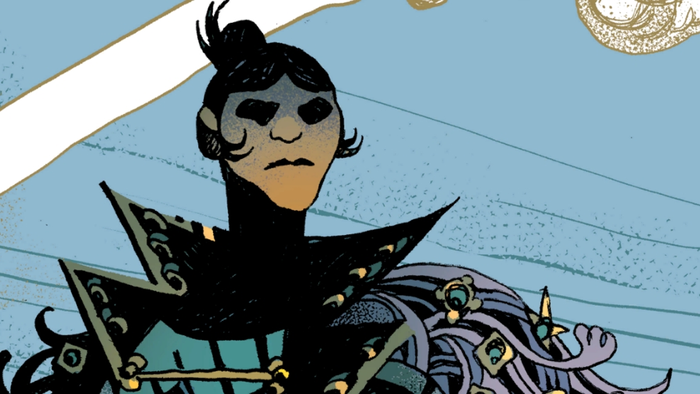Designer and writer Eron Rauch compiles a wide-ranging list of articles, essays, and other useful resources that game devs can use and share with each other to improve their game design discussions.

If you’re anything like me, you often find yourself lacking a precise way to explain an idea you have.
Especially when it comes to design and creative work done with other people, there seems to be an endless array of knotty and muddy conversations. I find myself thinking, “If I just had a word for that feeling, or for that… thing… I’d be able to solve the problem in a much more elegant way.”
Well, basically, the following reading list was put together precisely to help you find a few of those words for designing videogames.*
The original title for this resource, "A Few More Word-Tool-Things", is the result my videogame industry friends (“Hi Jason, Alec, and Sam!”) who prodded me to organize the articles I’ve mentioned during many years of late-night bullshit sessions about game design.**
As the list took shape, my friends suggested topics to research that would be useful for their work, and I went spelunking through endless bookmarks and web searches. The result is this reasonably low-investment and topical way for videogame designers to build their verbal tool kit.
The articles and videos are (with a few exceptions) all fairly short, mostly practical, and loosely arranged by theme. Since they range across a wide variety of design concepts and disciplines, I’ve also included a short summary of each as well as a hashtagged vocab word or phrase to help you better find what you’re looking for.
Use it like a weekly micro-book club with your team; randomly click on articles while you’re drinking a beer at lunch; or read it all from start to finish; however you approach it, I hope you find some interesting and useful words to help you build your projects.
*I’m going to use “videogames” (no space) based on Keogh’s argument that “video games” would technically refer to either A) Those weird 1980s VHS murder mystery games B) Electronic gambling machines; and as Futurama put it so succinctly, technically correct is the best kind of correct. Also, I really don’t care that much, so feel free use find/replace to add the space if you want.
**Those long-running conversations with industry friends are part of the reason you’ll find a disproportionate number of articles I’ve written in the list. Very often, my pieces have been a direct product of trying to answer the thorny questions that came up during those late-night bullshit sessions. So there’s necessarily quite a bit of overlap between what I’ve been writing about and the design topics. That’s right, I’m not a game designer, I’m an artist and arts writer who works with videogames as a core subject, so take any of my editorizaling with a grain of salt.
Level design and player interaction
What makes a game feel internally consistent? How do design, tone, narrative, and systems all come together to make something more than their parts (or cause each other to grind to a halt)? This essay proposes the idea of “coherence” as a way to discuss the relationships of the many moving parts in any game. #coherence
Meticulous statistical breakdowns of many of Final Fantasy VI’s innovations turn out to be surprisingly fascinating. The article’s subsections on ratios of character-to-villain dialog and World of Ruin item design are particularly useful examples of how to craft a coherent but still massive world. #dimmunation_of_class #villian_as_main_character #entire_dungeon

A clever rethinking of the much-ballyhooed “interactivity.” The essay points out that interactivity isn’t a particularly accurate term to describe what usually happens between the possibilities of game system and the players’ reactions to them. #interactivity
Why does everyone seem to be able to do an impression of Christopher Walken? What makes a joke land in standup routine? Why does a Mario game feel like a Mario game? It turns out they all utilize a similar hidden factor: cadence. #cadence
So what, exactly, does it mean to “complete” or “finish” a game? This simple question turns out to be much trickier to pin down than it first seems, with broad ramifications for the ways different players engage with the content of videogames. #full_experience
Survival games are all the rage, with many other types of games incorporating elements from the genre. But many of the most popular survival games turn out to have an incredibly particular relationship to cause and effect (and entertainment). #limited_power
A peek behind the oft-inscrutable curtain of the emergent systems of Dwarf Fortress; and also a deep look at alternative definitions of “play.” #story_generator
While the myth of the auteur permeates creative culture, this piece talks about the value of many unsexy parts of design, specifically, having good data to make better decisions about level design. #rational_level_design
Coming off the heels of a broader discussion about finding a better name than “Rogue-likes”, this essay opens up the conversation about the many ways we define genres, and how those definitions can drastically limit our conception about what is and isn’t possible (for instance “platformer” rather than “Mario-like”) #ludic_devices
Graphics, art assets, and building a place
With the race toward ever cleaner, 4K-ready graphics, it is important to remember that there are many kinds of other visual experiences. In this case, we have someone examining why the old, misty-muddy, version of Shadow of the Colossus feels more alive than the newer remaster. #fidelity
The videogame community regularly mistakenly uses “realism” when they are really referring to the much more specific artistic style of “photo realism.” But what other kinds of realism are there? #photorealism #neorealism
Grandeur and the sublime, distance and drama. a breakdown of the elements that combine to produce the feeling of expansive, panoramic vistas in games (using Destiny as an example). #panoramic #architectural_form
Traditional stereotypes of quality (wrapped up in sparkling Transformers-esque polish) often get in the way of creating compelling, coherent, and most importantly, memorable, game experiences.
A fantastic long-form look at how characters and narrative spaces in videogames end up gender-coded, and many strategies large and small to build projects with a broader potential audience of players. #gender_signifiers #gender_avatars
Big cities, like New York, Tokyo, or Los Angeles, have an almost palpable energy. This essay talks about why some cities in videogames feel so lifeless, while other manage to capture that organic life. #tactility
Graphics? Check. Action? Check. Coziness? Wha-? This report details the many unexpected ways the small but warm and welcoming places and characters do a surprisingly large amount of the heavy lifting to entice our imaginations into inhabiting imaginary worlds. #coziness
For decades, there has been an odd tendency to treat all videogames as impoverished versions of “true” VR worlds. But the assumption that videogames=virtual worlds can get in the way of an incredibly diverse number of other kinds of ways of thinking about, and making, videogames. #diagesis

There is an unfortunately long lineage of technical failures to image non-white skin tones stretching back into the history of photography. This continues in videogames in both big and small ways (such as having the lighting failing to differentiate darker skin tones against backgrounds). #under-lighting #backgrounding
It is a common trap to assume technique, style, and skill as some sort of naturally occurring force. This piece compares the history of Impressionist painting and indie videogames to show how how new, sometimes counterintuitive, techniques are tied to expressing new and novel ideas. #impressionism
Visual impact and meaningful imagery
While typical conversations about world design focus on the objects that populate the digital environment, the way the camera is utilized is a major factor in the emotional impact of the our experiences in digital spaces. #abstraction
We toss around the words “painterly” and “cinematic” as positive descriptions for highly refined technique. As videogames evolve as a medium, what might the hypothetical equivalent term (and expressive potential) mean for this digital form? #gamerliness
Negative space can be one of the most affecting elements of any visual composition, but by its very nature can be tricky to discuss. This piece take a look at the basics of negative space in art and also practically applies some of those examples to videogames. #negative_space
Looking at moody Parsian paintings from the 19th century, there is a glimmering gem to be discovered about how great creative works tend to build their world around advancing a core linkage of emotional and visual theme. #subject
Starry Night, Migrant Mother, The Blue Guitar; the arts are filled with intensely memorable images that resonate long after we see them. These two essays are two different looks at what game design might be able to glean from the history of image production, both in terms of traditional composition and the history of pattern-making. #visuall_substantial & #pattern

Loaded with innumerable glorious examples, this article shows the hidden but almost ubiquitous influence of a 1700s painter on videogame visuals. There is a massive inspiration board and thematic breakdowns of strategies like “vastness” and “pathways” that are ripe for stealing/inspiration. #romanticism
Storytelling, dramatic engagement, and narratives
Oh, the tired ol’ argument between stories and gameplay. This article is a special addition to that beleaguered conversation because of its willingness to roll up its sleeves and get dirty in the details, talking about, for instance, the rarely discussed and oft-confused difference between narrative, story, and plot. #narrative #story #plot
Agency is a buzzword in gaming, and has many more multilayered and subtly interlocking components than simple control. Curiously, by reconstructing the act of playing a game as a kind of performance, gaps and voids become a primary location of agency, which is good, because they’re rather cheaper endless branching story paths. #agency
Metafiction? Isn’t that some word for egghead literary theory majors? This essay breaks down the many ways games use metafictional elements and, critically, does a surprisingly good job of explaining what the hell metafiction is in the first place. #metafiction
NPCs are the dark matter of video game narratives, omnipresent and all-but invisible in our public conversation. This essay uses Shadows of Mordor and Watch Dogs as examples of the way our blindness to designing NPCs as dynamic, human, parts of games accidentally reduces the verbs players can use to experience these worlds. #interior_lives
I love when authors reach outside of the games canon to look at areas that feel ripe for inspiration. In this case, the essay uses the example of the beloved author Haruki Murakami to expand our understanding of ways to tell stories in videogames. #magical_realism
Offering a useful set of archetypes, with concrete examples from games, this article explores some of the more interesting and fully realized women characters in videogames. #strong_women
While not explicitly about videogames, this essay about master fantasy writer Ursula LeGuin talks through some of the subtle values that audiences get from stories, with a focus on how our ideas of self and history are built out of pieces of stories. #storytelling
For decades it has been common to compare videogames to movies, even to strive for more cinematic games. But there is a very strong argument to be made that games have far more in common with other art forms, like opera, than Hollywood. #gesamtkunstwerk
The idea of the holodeck, especially as constructed in the book Hamlet on the Holodeck, has been a cornerstone metaphor for how we understand stories in videogames. Similar to the article “Videogames are Boring”, this asks a fundamental question about what kinds of stories games are and aren’t choosing to tell, and how we tell them. #framing #configurative #performative #environmental #procedural (and for a viewpoint that engages with some of the questions of representation and politics embedded in the holodeck-narrative debate, check this out. #epsitomological_gatekeeping)
The Witcher III is a beloved game, and this essay pulls a number of lessons about the ways some of its writing contradicted its framing of its otherwise-powerful women characters. #narrative_potential
Fun and game feel
What happens when the way a player wants to play a game and the experience the game is trying to produce are at odds with each other? How does this happen? What are some solutions for enticing players to explore beyond their entrenched habits for experiencing games? #optimizing_fun
We talk endlessly about “fun” in the Western videogames community as though it were some monolithic, universal capital-T, Truth to strive for. In Japan, however, there are some nuanced adjacent terms that open up a broader landscape of enjoyment. #omoshiroi #tanoshi
This article is a bit on the academic tip, however it is worth including and struggling through because the argument here is super useful for designers. The piece basically tries to break down the artificial divide we have long assumed exists between our bodies and minds while we play videogames. The result is the capacity to make more totally compelling experiences that utilize all of relationship between player, controller and screen in a complex, embodied circuit (kind of like a cyborg system, which the diagram helps illuminate). #embodied
Is there anything more boring than negotiations in videogames? Yet in real life, negotiations are where an overwhelming amount of power is exercised by political, military and business leaders. This piece talks about ways to try to bridge this imaginative and game design gap. #diplomacy
There are endless unstated assumptions about crafting in videogames which leads to their zombie-fied reuse in most contemporary games. This article directly states what many people are thinking, but is considered impolitic to express, that: game crafting is usually boring, has none of the pleasure of real-life crafting, and most players don’t really value it. #alienating_labor
Marketing slogans endlessly shout about how much player choice matters. However, not all choices are equal. By breaking down the many kinds of choices presented to players, and defining what constitutes a meaningful choice, this essay highlights how the perception of choice might matter much more than any amount of wanton freedom. #meaningful_choice
A simple but effective proposition: Videogames aren’t a set of rules, they are a set of verbs. #verbs #syntax
Work work. Like, Warcraft’s peon Orcs, developers and fans increasingly replicate workaholism in videogames. This series of four pieces identifies possible causes and suggests strategies for making games that move past endlessly more stressful (and less memorable), productivity-oriented loops? #workification
While we’re on the topic of the homogeneity of fun, there seems to be an artificially limited number of ways that guns get deployed and used in games. What are other, potentially more meaningful ways for players to interact with guns in games? #consideration
What are the unseen assumptions we ask of players in videogames? So often developers and critics assume a level of highly specialized shared player skills (such as being able to circle-strafe and aim with WASD+mouse) without ever articulating to themselves the incredibly complex, learned system of inputs and visual parsing playing games require. What might we learn if we tried to tease out these hidden assumptions about our players’ interface with videogames? #machinic_assemblages
RNG, monetization, and eSports
Ever wondered what’s going on when your friend is cursing “IMBA!” through coms after dying to the same thing they always die to? This classic essay details the different mindsets and playstyles of “scrubs” and more serious competitors. #winning
Oh cruel god that is the Random Number Generator! It is frustrating as hell to repeatedly top-deck garbage in a digital CCG or die to a low-chance crit in a moba, yet the randomness also creates much of the drama in these games. Here are a few different takes on the complicated, fraught, role of chance and RNG in videogames. #catalogue_randomness #game-dertermining #apperance_of_randomness
Sports fandom is weird. Esports fandom is equally so. That broad assessment aside, even those of us who aren’t sports fans occasionally stare in awe a particularly stunning play, or feel our heart racing as a close game nears a tense end. This essay looks at the psychology and physiology of memorable moments in esports. #BIRGing #CORFing
What are some elements that make esports good for a spectator? This article digs into endless evolutions of Super Smash Brothers pro play and what it can teach us. #spectator_sport
Esports are currently overwhelmingly testosterone-fests, with a litany of young men on stage and an endless toxic spam of abuse filling Twitch chat. But most companies realize that if they want to grow and mature (and make more money) they’ll need to diversify their player-base and audience. A top researcher in the field shares what they’ve learned about women in esports. #inclusive
Big-picture thinking, politics, and games culture
Videogames often perform more as a genre than a medium, which vastly pre-limits its audience. These two brilliant, honest, essays pin down some of the primary reasons people fail to connect with videogames. #reconginized_taste #repulsed #friend-and-befriend
If you’ve ever been curious about how it came to be that videogames got so focused on catering to boys and young men (and why that might be bad for future growth) this excellent exposé digs deep into the history of games marketing. #stereotype_marketing #perpetuated_stereotype
Using Kentucky Route Zero as an example, this piece beautifully and delicately tries to draw out the complex web of impressions that happen when we have a moving experience with a game. #lost_together
Everyone loves cool-looking guns? Maybe? Well, at least it seems that way in the videogame community. Where does that desire come from? What are other uses of guns? These two related articles do a fantastic job exploring this hot-button issue. #tacticool #rail_system #power_fantasy #magic_wand_of_bullets
Does inclusivity and representation in videogames matter for marginalized and oppressed groups? If so, how? What are potential pitfalls of companies deploying marginalized identities? While hardly answering all these incredibly tricky questions, this article serves as a solid starting point to tackle these pressing issues. #representation
There is an unfortunate demographic trend that women tend to veer away from videogames as they grow older through childhood. This article looks at some of the possible reasons that happens, and in the process offers a few insights on what the industry might be able to do to retain women players. #gendered_out
It is hard to describe this experimental essay, except to say that is basically commits epithet-laden heresy on everything that the videogame industry and fandom holds dear. However, sometimes we all need a bit of a shocking outside perspective to disjunct us from our creative autopilot. #strange #possibility
What is the role of conversation, criticism, and feedback in videogames and art? This articulate, empathic essay attempts to unfold some of the complex relationships that come with making a creative media product like a movie or videogame. #critique #influence_spectrum #evaluative_writing
Certain genres of games get treated differently by the videogames industry, press, and fandom, and those expectations highlight blind spots in our the way we create and discuss games. #assumption
There are many kinds of power fantasies, and this essay highlights a new, particularly frustrating strain of power fantasy in videogames; one that vastly over-prioritizes the feeling of earned (accumulated) power in players, and why that fantasy fulfillment actually works against the kind of meaningful, memorable experiences we desire from games. #joy
This wildly entertaining video, rife with B-movie and late-night public access TV tropes, ends up in a very strange place, dragging the viewer through many evolving iterations of the question “Why do games matter?” #good #biased_inaccuracy
A short, beautiful rumination on how videogames and life intertwine in small but profound ways. #sublime #welcoming
Hiring methods, pay structures, and company culture often produce structural barriers for finding and retaining diverse workforces. This in-depth article looks more broadly at the tech industry as a whole, but is filled with observations and useful ideas for combating implicit bias, sexism, and other factors that cause these drifts toward gender imbalance in the games workforce. #hiring_goals #diversity #inclusion
The assumption of neutrality, of fairness, or balance, in videogame play and design is a constructed fiction. Owing to a number of psychological biases, we have trouble seeing these fictions, but by learning to identify our preconceived ideas, we open up new potential design choices. #false_concencous_effect #confirmation_bias #selection_bias
Whether it is BioShock or The Sims, the way videogame worlds are constructed always involves political and social decisions. Instead of fearing the maligned “P” word, when engaged with as an active part of design and not swept under the rug, these formulations often create some of the most compelling and expressive moments in games. #outward_intent #implications #reinforced_political_ideas
If you listen to the news, you’d swear that either videogames make us all violent criminals or solve all of the world’s ills. The truth of how games affect players is much more nuanced and dynamic than the tirades would have you believe. #influence #motivations
About the Author(s)
You May Also Like









